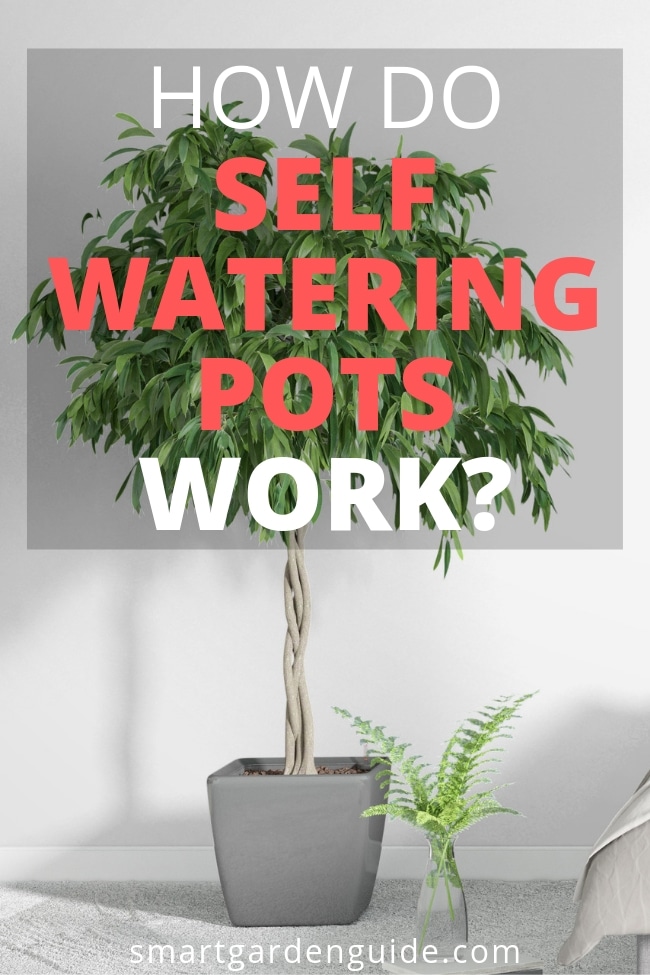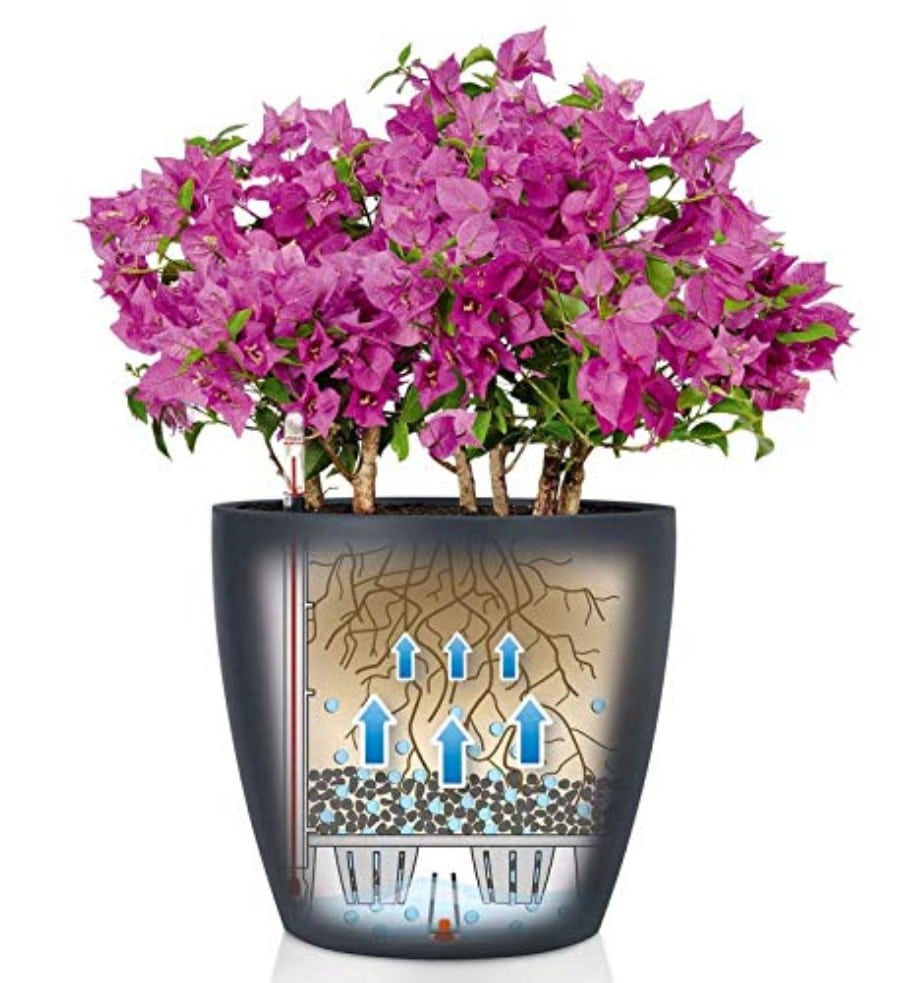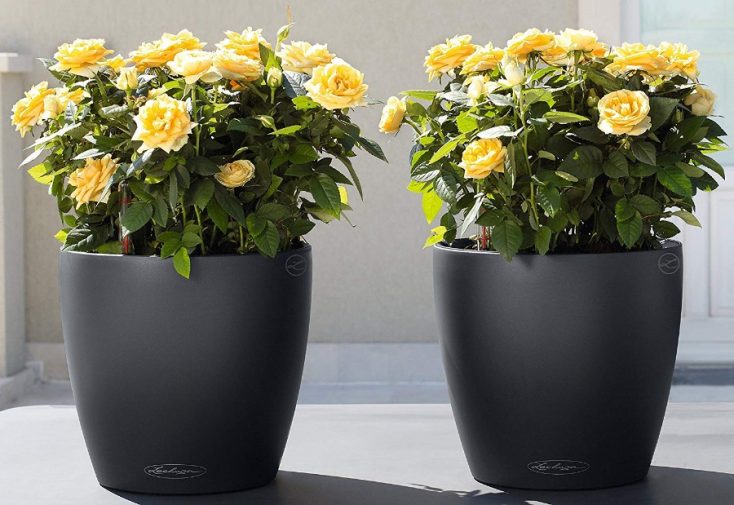Self-watering pots offer convenience, water efficiency, and improved plant health. These pots and planters use wicking action to provide water from a built-in reservoir, allowing you to water your plants by simply topping up the reservoir rather than having to keep track of the moisture level of the soil and watering according to each plant’s particular needs.
How do self-watering pots work? Consisting of a growing bed, potting soil, water reservoir, and wicking system that puts the soil in contact with the water, self-watering pots work through capillary action, or wicking. As the plant roots absorb water, the soil wicks up more, maintaining a consistent level of moisture in the soil.

Sometimes referred to as “sub-irrigation containers,” these self-watering pots have become quite popular because they are very effective and easy to maintain. They’re simple to construct using inexpensive, commonly available materials, or there are many stylish commercial options to choose from.
Although the design possibilities for these self-watering pots are endless, the four basic elements mentioned above always come together to form an elegant solution to houseplant care that’s perfect for today’s busy lifestyles.
Once you understand how these planters work, you’ll see why the self-watering pot trend has exploded onto the scene in recent years. So read on for an in-depth look at how self-watering pots work. You’ll be inspired to give these innovative planters a try.
Capillary Action (Wicking) Explained
The mechanism behind how self-watering pots work is a phenomenon called “capillary action,” or “wicking.” This action is what allows a sponge to draw up liquid from a surface, the hairs of a paintbrush to draw up paint, and the wick of a candle to draw up wax. This is also how plants, including the tallest trees, are able to overcome gravity to draw water up from their roots to the very top of the plant.
Capillary action is caused by the intermolecular attraction in liquids, along with the attractive forces between a liquid and a solid material with narrow tubes or small spaces within it. The attractive force between like molecules that holds a raindrop together is called “cohesion,” while the attractive force between the unlike molecules of a liquid and a solid material is called “adhesion” (think of dewdrops clinging to a flower petal or a leaf).
If the adhesive force between the liquid and the solid is greater than the cohesive force within the liquid, which occurs when the space between the walls of the solid material is sufficiently small, the liquid will be propelled within these spaces.
With self-watering pots, you need to thoroughly water the potting soil from the top at planting. Then, as the plants release water from their leaves, more water is drawn up by capillary action from the plant roots to replace it.
The water that’s absorbed from the soil by the roots is likewise constantly replaced by capillary action within the soil, being fed from the reservoir by the capillary action of the wicking system at the bottom. With the proper potting mixture and wicking mechanism, the soil remains consistently moist but not overly wet.
The Four Basic Elements Of A Self-Watering Pot
Regardless of whether it’s a single-plant pot or a large container garden, there are always four basic elements to these self-watering pots:
Growing Bed
The growing bed
Potting Soil
For a self-watering pot to function properly, it’s important that you use a potting soil that is lightweight and absorbent. It may consist of soil as well as non-soil growing media such as coco coir, perlite, or
The key is to use something that will continuously wick up water while also providing plenty of oxygen to the plant roots.
Water Reservoir
This essential element of a self-watering pot is located beneath the growing bed. Since you can’t see the reservoir, having a way to monitor the water level, such as a viewing window or a float, will eliminate the need for an overflow outlet for indoor planters.
And of course, there must be a way to refill the reservoir, which can be a vertical pipe for pouring in water from above or an opening at the side of the container.
The two separated areas for the growing bed and the water reservoir may be formed by placing a container at the bottom of the pot, by devising a barrier within the pot, or by having an inner pot for the grow bed and outer pot for the reservoir.
Wicking System
The wicking system is what delivers water from the reservoir to the soil and on to the plant roots. To achieve this, you can either use wicks made of absorbent material such as pieces of rope or strips of cloth that are situated with one end in the water and the other in the soil, or you can devise a wicking pot that puts the potting mixture directly in contact with the water in the reservoir below.
In the next two sections, we will take a closer look at each of these wicking systems.

Self-Watering Pot Wicks
One simple way to bring the water from the reservoir to the potting soil is to use wicks. You can use any kind of absorbent material for the wicks, including cotton, wool, felt, nylon, polyurethane, and microfiber.
However, for long-term use, its best to use a material that is durable and rot resistant, such as the fiberglass wicking that’s made for oil lamps and candle making, which you can find sold in bulk at some gardening suppliers.
When setting up a self-watering pot, you need to make sure that the wicks reach to the bottom of the reservoir so they will always be in contact with the water, even when the water level is low.
At the top end, the wicks should extend into the potting soil rather than sitting on the bottom of the growing bed. To achieve this, simply hold the top ends up when you pour the soil into the container.
The number of wicks you need will depend on factors such as the size of the container, the type of potting mixture, the wicking material, and the number and type of plants.
The general rule is to assume you will need two wicks per plant. However, you should test your wicks out with your soil to find out how well the system functions and be ready to make adjustments if your plants are not having their watering needs.
Wicking Pots
The other wicking system commonly used in self-watering planters is called a “wicking pot.” This describes any self-watering pot design that places the potting soil in direct contact with the water in the reservoir, separated only by a permeable barrier.
Some self-watering pots are actually wicking pots in and of themselves. This is the case with conversion kits that allow you to turn a regular flowerpot into a self-watering wicking pot by inserting a container for water into the bottom of the pot that has a perforated top, which serves as the base of the growing bed.
A wicking pot can also be created by placing a basket filled with potting soil so it extends down from the growing bed into the reservoir. The container needs to allow contact between the soil and the water, so use a basket or some other container with open sections in it. A lining of netting, window screening, or another thin, permeable fabric will hold the soil in.
Another way to create a self-watering wicking pot is to place a layer of gravel or sand in the bottom third of a container that doesn’t have drainage holes, cover it with permeable cloth, and then fill the rest of the container with potting soil.
You can use anything from an old sheet or T-shirt to shade cloth to reusable shopping bags for the cloth barrier. Be sure to insert a section of PVC pipe that will serve as your watering shaft before filling in the soil. You will need to cut a hole in the fabric for this.
What Are The Advantages Of Self-Watering Pots?
There are three major advantages to using these self-watering pots:
- Convenience
- Resource efficiency
- Improved plant health
Now, let’s take a look at each of these advantages.
Convenience
Perhaps the biggest selling point for self-watering pots is that they provide the convenience of simply making sure there is water in the reservoir rather than having to monitor the soil of each potted plant you have in order to supply water when your plants need it.
The task of keeping an eye on each individual planter can be time-consuming, particularly if you have a lot of plants. The watering needs of plants vary according to such factors as the time of year, the weather, the state of the potting soil, the size of the pot, the size of the plant, and the plant’s stage of growth. So when you water according to a weekly schedule instead of according to when the plants actually need it, you run the risk of harming your plants by over- or under-watering.
With self-watering pots, the soil is kept consistently moist, as the water is delivered from the reservoir at the same rate that the plants are using it.
Self-watering pots also offer the convenience of being able to water your plants while you are away from home or are so busy that you don’t have time to attend to your plants properly.
They thus allow people who travel a lot or have very busy lives to enjoy having houseplants without worrying about neglecting them.
Water Efficiency
Another major advantage of using self-watering pots is their water efficiency. These containers systems are self-regulating, delivering water as it is used by the plants. There is a small amount of water loss due to evaporation, but it’s much less than the amount of loss that occurs when you pour water into the potting soil from above – especially if you cover your self-watering potting soil with a layer of mulch
When you pour water into the top of the potting soil, some of it will evaporate from the surface. In contrast, because self-watering pots draw water from below, there’s less moisture at the surface of the soil and nearly all of the water is used by the plants.
Plant Health
The most common plant care mistake is over-watering, whichcan starve the plant of oxygen and lead to problems caused by fungus and disease, while under-watering deprives plants of the water they need to maintain their cellular structure, transport nutrients, and carry out photosynthesis. Self-watering pots can enhance the health of plants by providing exactly the amount of water they need as they need it.
Self-watering pots also encourage deep, healthy root growth, as the plant roots reach downward for water rather than growing laterally to gather water from near the surface, where the moisture level is highest.
What Are The Disadvantages Of Self-Watering Pots?
Self-watering pots are great for busy people, they’re environment-friendly, and they can enhance plant health – but there are a few disadvantages to these container systems:
- Self-watering pots are not suitable for all plants: Self-watering pots are not suitable for succulents, orchids, and other plants that need to have their potting soil dry out between waterings. The constant moisture will cause root rot in these types of plants.
- Self-watering pots don’t function well outdoors in moist or rainy climates: Outdoor self-watering containers will become waterlogged by high humidity and rain. An overflow outlet helps, but it doesn’t prevent the excess water from entering the soil in the first place and causing it to become wet rather than remaining evenly moist.
What Do I Need To Know About Maintaining A Self-Watering Pot?
While self-watering pots are very easy to maintain, there are a few things you need to do to help ensure that your plants are getting the water and nutrients they need.
Fertilizer And Self-Watering Pots
If you are using a hydroponic soilless medium in your self-watering pot, then you will usually need to add nutrients to the water reservoir, regularly maintain this nutrient solution at the proper levels, and flush the growing medium out with fresh water every couple of weeks to avoid the toxic buildup of fertilizer salts.
However, many gardeners prefer to avoid using liquid fertilizers and time-release fertilizers with self-watering pots to prevent salt buildup and instead feed their plants with compost. Flushing out self-watering pots can be tricky with indoor pots that have no overflow outlet.
Be sure include some well-aged sterile compost in your potting soil, and repot with a fresh batch of potting mix each planting season.
If you are using commercial self-watering potting mixture rather than creating your own, the best way to fertilize is to sprinkle a little slow-release fertilizer over the top of the soil before putting your plants in. This allows the fertilizer to slowly make its way down through the growing bed as the plants grow.
Do Not Allow The Reservoir To Dry Out
Self-watering pots are great for people who are always forgetting to water their plants, but you can’t forget to keep the reservoir from emptying because it will cause the wicking system to dry out and it won’t function when you refill the reservoir.
If you do happen to allow the reservoir to dry out, you will need to water from the top, soaking the soil well to ensure that it, along with the wicking system at the bottom of the pot, gets the moisture needed to start carrying out capillary action once again.
What Is The Best Self-Watering Potting Mix?
For a self-watering pot to function properly, it’s essential that you use the right potting soil. You can purchase commercial potting soils that are formulated specifically for self-watering planters. Or, make your own potting mixture with equal parts peat moss, coconut coir, perlite, and good-quality compost.
What Plants Are Best For Self-Watering Pots?
Houseplants that prefer evenly moist soil include smaller, leafy plants such as baby’s tears, spike mosses, and coleus, as well as larger thin-leaved plants such as b
What Are Some Of The Commercial Self-Watering Pot Options That Are Available?
There are many commercial offerings available on the market today that provide the convenience of pre-fabricated self-watering pots for your indoor houseplants. They may be stylish self-watering systems such as these:
Or, they may actually be hydroponic growing systems, like the following:
And finally, another great option is to purchase a conversion kit that will turn a regular planter into a self-watering system. Here are a few to choose from:

